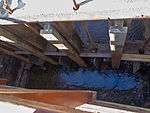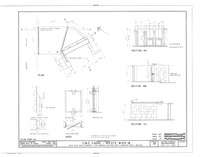Waste weir
A waste weir on a navigable canal is a slatted gate on each canal level or pound, to remove excess water and to drain the canal for repairs or for the winter shutdown.[1] This differs for a dam or reservoir, for which a waste weir is another name for a spillway, i.e. not having the boards to adjust the water height nor the paddles to drain all the water as on a canal, only to drain the excess.
Uses


A canal will often need some means to maintain a water level. A canal constantly consumes water due to leakage, evaporation, and the operation of lift locks. Nevertheless, excess water from storms or emptying locks [2] could cause problems eroding the banks of a canal, causing washouts, and flooding buildings or adjacent properties. Waste weirs were one of several items used to remove surplus water. The waste weir also functioned as an opening to drain the entire canal prism of water for repairs, or for winter (to avoid damage from freezing water), or in anticipation of flooding.[3][4]

In some cases when a creek was used to feed the canal, a waste weir was necessary for excess water from the creek. For instance on the Morris Canal, the Lopatcong Creek went into the canal to feed it, but it had a tendency to flood, hence the need for a couple of waste weirs in the area around the bottom of Inclined Plane 9 West near Port Warren, New Jersey (near Strykers Road today).[5]
Reservoirs and tanks also use a waste weir for flood discharges.[6]
Design

The maximum flow output in cubic meters/sec over the top of the waste weir with a length and height of water above the crest can be calculated by the formulas:
and
where g=gravitational constant of and Cd is the coefficient of discharge over the weir. [7] Various values of Cd can be given as follows:[8]
| Crest type | |
|---|---|
| Weir with crest up to one meter in width | 0.625 |
| Weir with crest greater than one meter in width | 0.562 |
| Rough stone sloping escape | 0.500 |
| Flush escape (no drop) | 0.437 |
Construction
Construction of course, varied depending on the canal. On the Erie Canal and the Chesapeake and Ohio Canal, waste weirs were often constructed from masonry or from concrete.
Law
Since a waste weir was part of canal property, it would sometimes be explicitly protected by law. On the Morris Canal, New Jersey Statue 136 section 61 stated for willfully and maliciously opening the gates of waste weirs the penalty was $25.[9]
Gallery
 Waste weir. Note boards to adjust water height. The wicket at Pennyfield lock were open, draining the canal of water, hence, why the water level is lower than the boards.
Waste weir. Note boards to adjust water height. The wicket at Pennyfield lock were open, draining the canal of water, hence, why the water level is lower than the boards..jpg) Boards are out. Note the iron wickets (paddle valves) closed. Those could be opened to drain the canal further.
Boards are out. Note the iron wickets (paddle valves) closed. Those could be opened to drain the canal further. Concrete Waste weir. Note rods for attaching handles to control paddle valves.
Concrete Waste weir. Note rods for attaching handles to control paddle valves..jpg) Outflow from the waste weir at Swain's Lock.
Outflow from the waste weir at Swain's Lock. A small waste weir without paddle valves to drain the prism.
A small waste weir without paddle valves to drain the prism. A circular overflow weir on the Droitwich canal
A circular overflow weir on the Droitwich canal
References
- Kytle, Elizabeth (1983). Home on the Canal. Cabin John, MD: Seven Locks Press. ISBN 978-080185328-9., p. 272-273
- For instance, a lock on the Chesapeake and Ohio Canal was typically 15 feet wide, 95 feet long, and with an 8 foot lift requires 11400 cubic feet or 85,000 gallons to fill. These are small compared to locks on modern canals such as the Panama canal.
- "The Waste Weir". Union College. Retrieved 2013-10-06.
- "The Waste Weir". The Erie Canal Village. Retrieved 2013-10-06.
- http://www.morriscanal.org/Signage/Water%20and%20the%20Canal.pdf
- Bligh, William George (1907). The Practical Design of Irrigation Works. D. Van Nostrand. pp. 335.
- Challa, Satya Narayana Murthy (2009). Water Resources Engineering: Principles and Practice. New Age International Pvt Ltd Publishers. p. 52. ISBN 978-8122413823.
- Challa, p. 47
- Compiled Statues of New Jersey, vol 3., p. 4274 at https://books.google.com/books?id=WtJGAQAAIAAJ&lpg=PA4274&ots=SMyhXt5a_z&dq=%22Morris%20Canal%22%20%22waste%20weir%22&pg=PA4274#v=onepage&q=%22Morris%20Canal%22%20%22waste%20weir%22&f=false